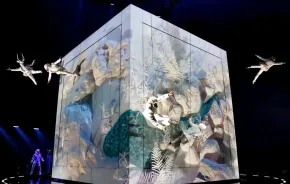Pacific Northwest Ballet's repertoire is full of dances that defy ballet stereotypes, but its production of The Sleeping Beauty is pure tradition. Ronald Hynd’s choreography, set to the original Tchaikovsky score, is a close reproduction of Marius Petipas’ 1890 original. If you crave a story ballet with tutus, elaborate sets and dancers filling the stage in kaleidoscopic patterns, The Sleeping Beauty is the ballet for you.
Divided into a Prologue and three acts, the ballet follows Princess Aurora’s well-known story. It is an incredibly technical ballet, with lots of pointe work, long balances and precise movements, but the technicality could easily be overlooked amidst the elaborate sets and sumptuous costumes.
The Prologue is all pomp and ceremony until the arrival of the fairies. Their individual dances represent gifts to the baby princess. The evil Carabosse flies in on wires to deliver her curse.
In Act I, villagers bring garlands to the castle in a waltz familiar to young Disney fans as “Once Upon a Dream.” Aurora and four dukes dance the famous, intricate, Rose Adagio. As each duke slowly spins Aurora in a full circle, she balances en pointe for an impossibly long time. Carabosse returns disguised as an old hag, and gives Aurora a spindle. Having no more idea than Aurora what a spindle was, my 5-year-old gasped when Aurora pricked her finger and watched in concern as enchanted vines covered the castle.
One hundred years later, Prince Florimund goes hunting in the woods. The party of aristocrats and peasants perform rustic dances before the chase, but when the hunt begins, the prince lingers behind. The Lilac Fairy appears and presents him with a vision of the sleeping princess. The rigid symmetries of the choreography are somewhat softened in the dream dance. Enchanted, the prince follows the Lilac Fairy to the castle and awakens Aurora.

The final act returns to pomp without sacrificing technical fireworks in a grand wedding attended by fairy tale characters. Each guest performs a dance; the feline antics of Puss in Boots and his date were audience favorites. Aurora and Florimund dance a stunning pas de deux. In a grand finale, with everyone on stage, the Lilac Fairy and her nymphs appear in the sky, blessing the couple.
Parents should know
Story ballets are the traditional entry point into ballet, but at three hours (including three 15-minute intermissions), The Sleeping Beauty may tax younger viewers’ stamina, and many preschoolers may have a hard time holding onto the thread of the story. Preschoolers who have already enjoyed The Nutcracker may be ready for the challenges of Sleeping Beauty as a next step, and school-age children should be fine.
Violence in the ballet centers around the evil fairy Carabosse, who literally enters with a bang (and a puff of smoke). She is an effective villain without being too scary, but in Act I she attacks a member of the court (pulling out his hair) and kills one of the dukes with a magic spark. In Act II, Prince Florimund kills Carabosse with a sword.
Kid quote
“I think that fairy is Laughter.”
Parent tips
- Complimentary booster seats are available. Binoculars can be rented for $5, or you may bring your own.
- Everyone, including babes in arms, must have a ticket.
- Food is not permitted in the auditorium, but snacks during intermission are highly recommended.
- There are several concession areas and a full service restaurant at McCaw Hall. You can place concession orders before the performance begins, and your snacks will be waiting for you at intermission. Preordering is recommended, because lines can be longer than intermissions; you risk running out of time before you reach the register.
- Try to arrive early. At matinees, there are craft and activities for children before the show.
- If your child has difficulty watching and listening quietly during the performance, you can watch it on monitors in the lobby.
- More tips for planning your visit can be found online. Resources for preparing your kids, like videos and stories, are available online, too.
- As far as parking, the Mercer Garage is connected to McCaw Hall by a sky bridge. Rates vary from $5-$15 depending on events at Seattle Center. Other pay lots in the neighborhood have similar pricing. Street parking is limited to 4 hours, and hard to come by. Consider taking the bus – look online












